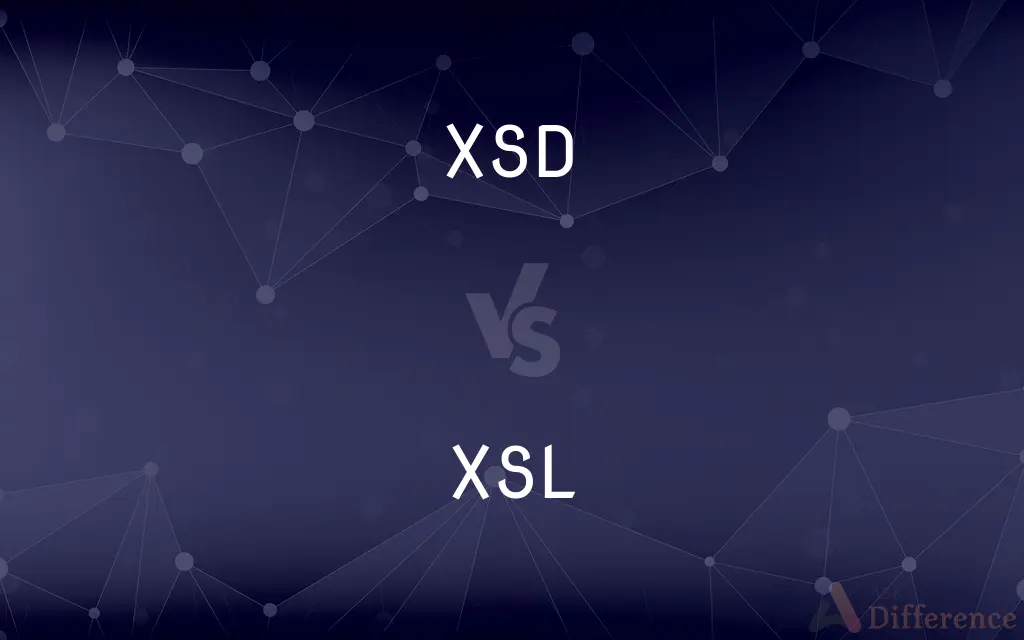XSD vs. XSL — What's the Difference?
By Maham Liaqat & Urooj Arif — Published on November 15, 2024
XSD (XML Schema Definition) defines the structure and data types of XML documents, ensuring data integrity, while XSL (eXtensible Stylesheet Language) transforms XML documents into various formats, focusing on presentation and layout.

Difference Between XSD and XSL
Table of Contents
ADVERTISEMENT
Key Differences
XSD is used to validate the structure and content of XML documents, specifying what data is valid in an XML document, including elements and attributes. It helps in ensuring that XML documents conform to predefined rules and structures. XSL, on the other hand, is a language used for transforming XML documents into other formats like HTML, text, or another XML document, primarily focusing on the presentation and styling of data.
XSD enables developers and applications to validate XML documents, ensuring they meet specific criteria before processing, thus enhancing data integrity and reliability. This is crucial in data exchange and web services where precise data structure is required. XSL, through its component XSLT (XSL Transformations), allows for the dynamic transformation of XML data, making it adaptable for various display environments, such as web pages or print formats.
By defining exact data types, element sequences, and cardinality, XSD provides a method for defining the structure of XML data in a detailed and precise manner. This contrasts with XSL, which focuses on the aesthetics and layout of this data when presented, without imposing any constraints on the data's actual structure or integrity.
XSD is integral in scenarios where data validation and structure are critical, such as in enterprise data exchange and configuration files for complex software systems. XSL is indispensable in scenarios requiring the versatile presentation of XML data across different media and platforms, enhancing accessibility and user experience.
XSD operates by enforcing rules and structures on XML data, ensuring that the data adheres to specified formats and types, whereas XSL works by transforming and presenting this data in a visually or structurally different form, emphasizing the flexibility and reusability of XML data across various applications.
ADVERTISEMENT
Comparison Chart
Purpose
Defines the structure and types of XML data
Transforms XML documents into different formats
Focus
Data integrity and validation
Presentation and layout of XML data
Components
-
XSLT (Transformations), XPath (navigation), and XSL-FO (formatting objects)
Use Cases
Data interchange, web services
Web page rendering, document generation
Output
Validation report (valid/invalid)
Transformed document (HTML, PDF, etc.)
Compare with Definitions
XSD
Used in web services for consistent data communication.
An XSD defines the structure of SOAP messages in a web service.
XSL
Enhances XML document presentation.
XSL-FO defines how to format XML data for print.
XSD
A language for defining XML document structure and constraints.
An XSD can specify that a date element must be in the YYYY-MM-DD format.
XSL
A language for transforming XML documents.
XSLT can convert XML data into HTML for web display.
XSD
Defines data types and element relationships.
An XSD can define an element as an integer with a maximum value of 100.
XSL
Allows for dynamic content generation.
Using XSLT to create different output formats from the same XML source.
XSD
Ensures XML document validity.
An XSD checks that an XML file contains all required elements.
XSL
Integrates with other web technologies.
XSLT transformations can be applied in web browsers or servers to dynamically render XML data.
XSD
Facilitates data exchange between systems.
An XSD ensures that an XML document sent from one system to another adheres to expected standards.
XSL
Facilitates multi-platform document presentation.
Transforming XML into PDF, HTML, or text formats for various uses.
Common Curiosities
What output formats can XSL produce?
HTML, PDF, text, and other XML documents, depending on the transformation applied.
Can XSD and XSL be used together?
Yes, XSD can define the structure of XML data, while XSL can be used to transform and present this data.
How does XSL transform XML documents?
Through XSLT, part of XSL, which applies templates to XML documents to produce different output formats.
What is the primary use of XSD?
To define and validate the structure and data types of XML documents.
How does XSD improve data interchange?
By ensuring that XML documents adhere to a defined structure and type system, facilitating reliable data exchange.
Is knowledge of XSD necessary for working with XSL?
Not necessary, but understanding the structure of XML can help in creating more effective XSLT transformations.
What are the components of XSL?
XSLT for transformations, XPath for XML path navigation, and XSL-FO for formatting objects for print.
Can XSL be used for data validation like XSD?
No, XSL focuses on presentation and layout, not on data validity.
Is XSLT the only component of XSL used for transformations?
Yes, XSLT is specifically designed for transforming XML documents into other formats.
What role does XPath play in XSL?
XPath is used within XSLT to navigate and select parts of an XML document for processing and transformation.
How does XSL enhance XML's usability?
By allowing XML data to be transformed and presented in various formats, XSL enhances the accessibility and versatility of XML documents.
How do XSD and XSL affect web services?
XSD ensures consistent data structure in web services, while XSL can be used to transform and present data from web services.
How does XSL-FO complement XSLT?
While XSLT focuses on transforming XML data, XSL-FO specifies how to format the transformed data for printing or display.
Can XSD handle complex data structures?
Yes, XSD is capable of defining complex data structures with nested elements and attributes.
What makes XSD crucial for XML document design?
It provides a method for defining permissible content, ensuring that documents adhere to specific standards and structures.
Share Your Discovery

Previous Comparison
English Breakfast Tea vs. Irish Breakfast Tea
Next Comparison
Grinder vs. MillAuthor Spotlight
Written by
Maham LiaqatCo-written by
Urooj ArifUrooj is a skilled content writer at Ask Difference, known for her exceptional ability to simplify complex topics into engaging and informative content. With a passion for research and a flair for clear, concise writing, she consistently delivers articles that resonate with our diverse audience.














































